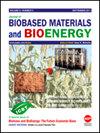An Evaluation of the Contribution of Cellulose, Hemicellulose and Lignin to Bio-Char Combustion and Adsorption Properties
IF 0.5
4区 医学
引用次数: 0
Abstract
The present work focuses on the contribution of cellulose, hemicellulose, and lignin for bio-char application in two aspects: fuels and adsorbent. The pyrolysis behaviors were studied at 300 to 700 °C, and the yields and characterization of bio-chars were compared. The results showed that in the three components, lignin was responsible for the formation of bio-char products, representing the main source of bio-char characterized by high heating value. Lignin was the strongest support for prepared bio-char as fuel decided by physico-chemical properties and combustion reactivity, while cellulose was the major contributor for bio-char products as ignition fuel. Scanning electron microscopy (SEM) and surface area analysis of bio-char showed that, in the three components, cellulose derived bio-chars exhibited a distinctive fibrous structure and the surface area was the largest at the same pyrolysis temperature. Compared with lignin, hemicellulose was a better precursor for adsorption, it is mainly determined by complex and abundant pore structure. Further adsorption tests of toxic substances in soil showed that, cellulose represented major adsorption donator for phenol, all bio-char samples had better adsorption capacity for Pb(II) than Cu(II), the rule on adsorption capacity of three different precursors for Cu(II) was as follows: cellulose>hemicellulose>lignin, for Pb(II): hemicellulose> cellulose> lignin.评估纤维素、半纤维素和木质素对生物炭燃烧和吸附特性的贡献
本研究的重点是纤维素、半纤维素和木质素对生物炭在燃料和吸附剂两方面应用的贡献。研究了在 300 至 700 °C 下的热解行为,并比较了生物炭的产量和特性。结果表明,在三种成分中,木质素是形成生物炭产品的主要成分,是生物炭的主要来源,具有高热值的特点。从物理化学性质和燃烧反应性来看,木质素是制备生物炭作为燃料的最有力支持,而纤维素则是生物炭产品作为点火燃料的主要贡献者。生物炭的扫描电子显微镜(SEM)和表面积分析表明,在三种成分中,纤维素衍生的生物炭表现出独特的纤维状结构,在相同的热解温度下,其表面积最大。与木质素相比,半纤维素是一种更好的吸附前体,这主要是由复杂而丰富的孔隙结构决定的。对土壤中有毒物质的进一步吸附测试表明,纤维素是苯酚的主要吸附捐献者,所有生物炭样品对铅(II)的吸附能力均优于铜(II),三种不同前驱体对铜(II)的吸附能力规律为:纤维素>半纤维素>木质素,对铅(II)的吸附能力规律为:半纤维素>纤维素>木质素。
本文章由计算机程序翻译,如有差异,请以英文原文为准。
求助全文
约1分钟内获得全文
求助全文

 求助内容:
求助内容: 应助结果提醒方式:
应助结果提醒方式:


